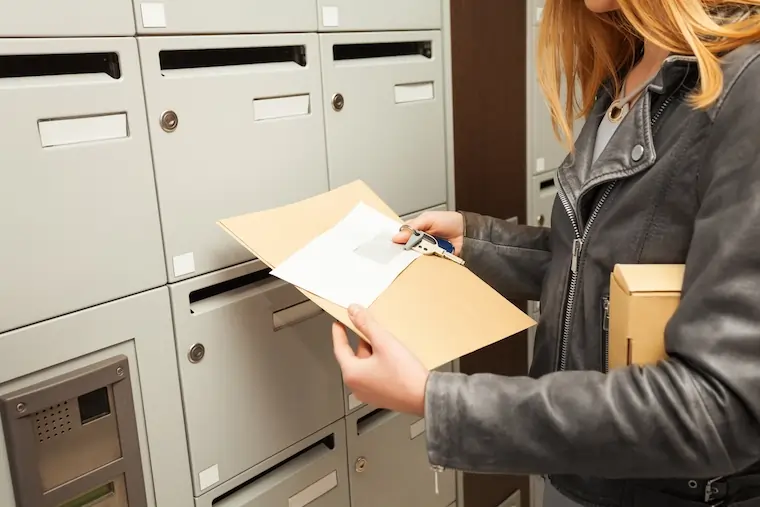In this article, we’re answering “what is a mailing address?”
This will include a comparison to other address options, examples of mailing addresses that you can use, and other important considerations.
This article is part of our free series answering questions like “how to open accounts” and “can I keep my bank account if I move abroad” – click here to access the rest of the series now.
Feel free to use the table of contents to jump ahead to the sections most relevant to you.
Table of Contents
- What Is a Mailing Address?
- Physical Addresses vs a Mailing Address
- Mailing Address Options
- Frequently Asked Questions
- Ready to Explore Your Options?
What Is a Mailing Address?
A mailing address is a dedicated address where an individual or company chooses to receive mail. In most cases, a mailing address is the same address as a person’s home address or a company’s business address. However, certain individuals and companies may choose to use a second address to receive mail instead.
There are a number of reasons why someone may choose to receive mail at a different address other than their home or business address. One of the main reasons for this is the added privacy and security that it can offer. By choosing to use a post office box address, forwarding service, or another address location, businesses and individuals can continue to receive correspondence without disclosing their exact location publicly.
Other reasons may include being required to have a mailing address in a specific country or state in order to receive correspondence related to business or legal matters. In such instances, businesses may choose to obtain a post office box for local mail, which can facilitate faster (and more affordable) correspondence than sending mail internationally.
Lastly, it is possible to open bank accounts with a mailing address instead of a physical address at certain banks. However, not all banks accept a post office box address. In fact, even those that do may have additional requirements that you will need to meet in your country of residence.
Physical Addresses vs a Mailing Address
The main difference between physical addresses and mailing address is that a physical address is generally a leased or owned property that you or your business occupy, while a mailing address is generally a location that is strictly used by you or your business for correspondence purposes.
That said, it is possible for both addresses to be the same, though many individuals and businesses choose to use both. For this reason, most businesses or financial institutions ask for this as an optional address when completing formal documentation or onboarding forms. In other words, if you wish to receive correspondence at an address other than your physical address, you would include this second address in addition to the physical address.
Do You Want Our Free Non-Resident Banking Guide?
Sign up here to receive our Free Non-Resident Banking Starter Guide and weekly updates on the best account opening options available:
Mailing Address Options
Mailing address options include a number of different services and locations, ranging from formal mail forwarding services to virtual office addresses. That said, the most popular option is a post office box (P.O. Box) address, which is available in most countries around the world.
Here’s a closer look at a few of the most popular options.
P.O. Box Address
Post office box addresses are commonly used to receive both business and personal correspondence, including mail and packages. In addition to offering security, a P.O. Box also ensures that packages are not left unattended for long periods of time. Also, it’s worth noting that certain banks will accept a P.O. Box address when opening accounts.
Virtual Address
Virtual address is a blanket term for an address that an individual or business can use as their own through a professional service provider. However, it’s worth noting that many virtual address providers are in fact repackaging post office box addresses from large providers like UPS, Staples, and elsewhere. That said, they offer a competitive service and in most cases can assist you with quickly completing the legal requirements to obtain an address through their online portals.
Physical Address
As mentioned, individuals and businesses can also choose to use their physical address as a mailing address. In other words, a person’s primary residence or a business’ primary operating location. Physical addresses like this are acceptable for correspondence purposes. However, individuals and business owners need to be comfortable with the address being shared with the party they’re corresponding with.
Other Mailing Addresses
In addition to post office boxes, virtual addresses, and physical locations, both individuals and businesses can choose from other options as well. In the past, we have seen other people use less formal options like the address of a friend or family member and businesses sign a lease agreement with another company for the purpose of receiving mail at another address. Of course, before choosing less formal options, you should make sure that they are accepted in the jurisdiction where you plan to receive mail as different countries and states regulate the sending and receiving of mail differently.
Frequently Asked Questions
Below are three of the most common questions that we receive from people looking into what a mailing address is. If you have further questions you would like answered, don’t hesitate to get in touch with us directly.
What Is a Mailing Address Example?
An example of a mailing address is a post office box (P.O. box) address. However, there are other mailing address examples as well. These other examples include virtual office addresses, coworking space addresses, physical addresses, and more. In short, any address where an individual or business elects to receive correspondence falls into this category.
Is a Mailing Address the Same as the Permanent Address?
A mailing address can be the same as a permanent address if the person listing the address chooses to receive mail at that location. However, certain individuals and businesses choose to use a separate address from their permanent address. That said, if you prefer to receive mail directly at your primary residence or your place of business, you can use these locations for correspondence purposes.
What Is the Difference Between a Home and a Mailing Address?
The main difference between a home address and a mailing address is that a home address is your primary residence, while your mailing address is where you choose to receive mail. Importantly, these two addresses can be the same. However, many people choose to use a separate address instead for privacy, security, and efficiency reasons.
Ready to Explore Your Options?
If you would like assistance navigating your banking options at home or abroad, we can help.
You can access GlobalBanks IQ, our international banking intelligence platform, in just a few clicks. Unlock our bank database, individual bank profiles, account opening strategies and reports, banker scripts, and more.
But, if you want a 100% personalized account opening service that taps into our team’s expertise and provides direct banker introductions, you can get started with GlobalBanks Insider.
Of course, if you have any questions, please contact us directly.

